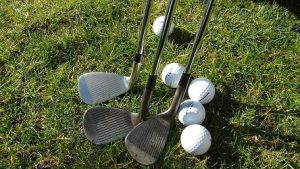Golf balls are an essential part of playing the sport of golf. Over time, golf balls can become damaged or worn, which can affect their performance on the course. So, how long are golf balls good for?
The lifespan of a golf ball can vary depending on a few factors. Firstly, the quality of the golf ball will impact its durability. High-quality golf balls made by reputable brands are generally more durable and long-lasting than low-quality, cheap balls.
Secondly, the frequency of use and storage conditions can also impact the lifespan of a golf ball. If a golf ball is used frequently or stored in poor conditions, such as extreme temperatures or moisture, it may become damaged more quickly.
In general, golf balls can last for several years if they are well-maintained and stored properly. It is recommended to replace your golf balls every 1-2 years to ensure consistent performance on the course. However, if you notice any visible signs of wear or damage, such as cracks, scuffs, or deformation, it may be time to replace them sooner.
It is also important to note that the rules of golf specify that golf balls cannot be used if they are significantly damaged or altered, such as by cutting or marking. So, even if a golf ball appears to be in good condition, it may not be legal for use on the course if it has been altered in any way.
It is also worth noting that the type of golf ball you use can impact its lifespan. There are three main types of golf balls: two-piece, three-piece, and four-piece balls. Two-piece balls are generally the most durable and long-lasting, while four-piece balls are more delicate and may not last as long.
Another factor that can affect the lifespan of a golf ball is the conditions in which it is used. For example, if you frequently play on courses with rough or abrasive surfaces, such as sand traps or gravel areas, your golf balls may become scuffed and worn more quickly.
Similarly, if you frequently play in wet or muddy conditions, your golf balls may absorb water and become heavier, which can impact their flight and distance. In these cases, it may be necessary to replace your golf balls more frequently.
To extend the lifespan of your golf balls, it is important to store them properly. Golf balls should be stored in a cool, dry place away from direct sunlight and moisture. Exposure to extreme temperatures or humidity can cause golf balls to deteriorate more quickly.
Golf Ball Shelf Life
| Brand | Model | Shelf Life (Years) | Storage Conditions | Price per Dozen |
|---|---|---|---|---|
| Titleist | Pro V1 | 2 | Cool and dry place, away from direct sunlight | $49.99 |
| Callaway | Chrome Soft | 3 | Room temperature, humidity below 70% | $44.99 |
| TaylorMade | TP5 | 2 | Temperature range between 40°F and 90°F | $47.99 |
| Bridgestone | Tour B X | 2 | Avoid extreme temperatures, store in original packaging | $45.99 |
| Srixon | Z-Star | 2 | Keep away from water, store at room temperature | $39.99 |
| Vice | Pro Soft | 2 | Store in a dry place, avoid exposure to heat | $34.99 |
| Mizuno | RB 566 | 2 | Store in a cool, dry place | $32.99 |
| Wilson | Staff Model | 2 | Avoid exposure to extreme temperatures and humidity | $39.99 |
| Volvik | Vivid | 1 | Store at room temperature, away from direct sunlight | $37.99 |
| Kirkland Signature | 3-Piece | 2 | Store in original packaging, avoid extreme temperatures and humidity | $29.99 |
Factors Affecting Golf Ball Lifespan
| Factor | Description |
|---|---|
| Usage | Frequent use can cause the ball to lose its shape and degrade faster. |
| Temperature | Extreme temperatures (both hot and cold) can damage the ball’s cover and core. |
| Humidity | High humidity can cause the ball’s cover to absorb moisture, which can affect its performance. |
| Sunlight | Prolonged exposure to sunlight can cause the ball’s cover to fade and crack. |
| Storage | Improper storage conditions (such as in a damp or humid area) can shorten the ball’s lifespan. |
Signs of a Worn-Out Golf Ball
| Sign | Description |
|---|---|
| Scuff Marks | Scratches or scuffs on the cover can affect the ball’s aerodynamics and distance. |
| Discoloration | Faded or discolored covers may indicate that the ball is losing its elasticity and performance. |
| Deformation | Dents, flat spots, or bulges on the ball can affect its flight and accuracy. |
| Cracks | Visible cracks on the cover or core can cause the ball to lose its compression and distance. |
| Water Absorption | A ball that has absorbed water may feel heavier and not travel as far as a dry ball. |
How to Extend the Lifespan of Golf Balls
| Tip | Description |
|---|---|
| Store in a Dry Place | Keep golf balls in a cool, dry place away from direct sunlight and moisture. |
| Rotate Balls | Rotate golf balls in use to avoid putting too much stress on any one ball. |
| Clean After Use | Clean golf balls after use to remove dirt and debris that can affect their performance. |
| Play on Soft Ground | Playing on soft ground (such as grass) can help reduce the impact and stress on the ball. |
| Use Ball Markers | Using ball markers instead of picking up and replacing balls can help prevent scratches and scuffs. |


